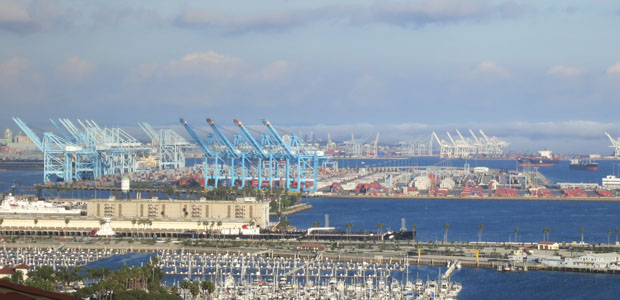
The Ports of Long Beach and Los Angeles, the two largest in the nation, released an updated joint clean air plan today.
The cost of cleaner air at the Ports of Long Beach and Los Angeles could cost as much as $14 billion according to a draft action plan released by the port complexes today.
The 2017 San Pedro Bay Ports Clean Air Action Plan (CAAP) calls for cleaner trucks, improved on-dock rail infrastructure, transitioning the oldest, most polluting ships out of its fleet and speeding up the deployment of cleaner harbor craft in an attempt to transition to zero-emission trucks by 2035 and zero emission terminal equipment by 2030.
It also seeks to develop updated port terminal equipment including electrified equipment, alternative fuels and decrease truck turn times.
The announcement comes the same week that state lawmakers voted to extend California’s cap-and-trade program through 2030. The program requires entities to buy permits for the ability to pollute as a mechanism to drive businesses into greener practices.
In improving efficiencies at the port complexes, the ports could also further reduce the pollution that has exposed residents in the region to particulates which have contributed to higher than average asthma and cancer rates as well as other medical conditions.
“These ports are going where no port has gone before,” said Port of Los Angeles Executive Director Gene Seroka in a statement. “Based on what we’ve already accomplished to promote healthy, robust trade through our gateway, we’re ready to make history again, looking at a new array of technologies and strategies to further lower port-related emissions in the decades ahead.”
The ports have set a long-term goal of getting to a point where 50 percent of its goods are shipped by on-dock rail tracks versus the more pollutant producing semi-trucks that currently rumble around the port complex.
The 2017 CAAP aims to reduce greenhouse gas emissions by 40 percent below 1990 levels by 2030 and 80 percent below those baseline levels by 2050. The updated plan maintains its previously stated 2023 goals of cutting diesel particulate matter (by 77 percent), sulfur oxides (by 93 percent) and nitrogen oxides (by 59 percent) below 2005 levels.
All three substances have been linked to increased likelihood of respiratory illness, and in high concentrations, can be fatal.
Wednesday afternoon, California Trucking Association CEO Shawn Yadon, CTA Intermodal Conference Executive Director Alex Cherin and Harbor Trucking Association Executive Director Weston LaBar released a joint statement following the release of the CAAP where they cautioned balance when in achieving environmental goals while taking into account the costs incurred by those who must replace older trucks with those compliant with the updated action plan.
“For an industry that has already invested more than $1 billion to meet and exceed the stated air emission goals of the first CAAP, we must continue to pursue a balanced approach that pushes forward new technology and further reduces emissions without overly burdening truckers,” the statement said.
“We look forward to working with our partners to implement the operational goals—including the goal of meeting an hour-visit time at our terminal facilities—that have now been identified as a critical component of the Ports’ clean air strategy.”
Long Beach is committed to implementing the CAAP’s innovative approaches, ensuring cleaner, greener seaports: https://t.co/s6CXJNisQ2 pic.twitter.com/7IefQVMqZf
— Long Beach Mayor (@LongBeachMayor) July 19, 2017
After a years-long process to get to the draft document stage, the document is now open for a public review and comment period through September 18. The ports will host a public workshop at Banning’s Landing Community Center in Wilmington August 30 at 5:00PM where community members can comment in person.
For those not able to make the August 30 meeting, written comments can be submitted here until the September 18 deadline at 5:00PM. A public meeting held by harbor commissioners from both ports is expected to take place in November when the two bodies could consider a final draft of the CAAP.
“Working closely with all our partners has been crucial to our success. That same collaboration went into the development of the 2017 CAAP and will be indispensable going forward,” said Port of Long Beach Executive Director Mario Cordero in a statement. “Since 2006, the Clean Air Action Plan has been a model for programs to reduce health risks and air quality impacts from port operations worldwide. We remain committed to being leaders in seaport sustainability.”
[Editors note: the original version of this story listed Alex Cherin as the CEO of the California Trucking Association instead of the Executive Director of the CTA Intermodal Conference. The story has been updated to correct that error.]

